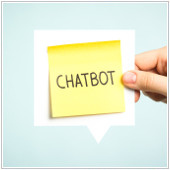 In today’s tech-centric world, the demand for new apps is overwhelming the supply. Whether due to simple curiosity or just plain excitement, people are usually drawn to chatbots. In time, however, novelty wears thin and people lose interest. This may be partially due to the fact that bots aren’t as engaging as we initially imagined them to be. Fortunately, the silver lining here is that necessity — or in this case, boredom — is the mother of invention, so people customize these chatbots to create a better experience.Here are 5 tips to get you started:
In today’s tech-centric world, the demand for new apps is overwhelming the supply. Whether due to simple curiosity or just plain excitement, people are usually drawn to chatbots. In time, however, novelty wears thin and people lose interest. This may be partially due to the fact that bots aren’t as engaging as we initially imagined them to be. Fortunately, the silver lining here is that necessity — or in this case, boredom — is the mother of invention, so people customize these chatbots to create a better experience.Here are 5 tips to get you started:
Emulate the WeChat Model
This Chinese cross-platform instant messaging app has housed chatbots since 2011 and shows no signs of letting up. When compared with other countries, China’s bot market is at a further development stage, meaning there are many things to learn from WeChat’s chatbots. Here a few of them:
- Two types of bot accounts: WeChat offers Subscription and Service accounts. Subscription accounts mainly gather news and blogs, whereas Service accounts are fully-functional bots that offer features like speech recognition as well.
- News: News bots make up over 34 percent of the Top 500 Bots in China. This means that WeChat is the main news source for Chinese citizens.
- Top five categories: Current Affairs, Culture, Entertainment & Sports, Humor, and Emotions – these five categories compose almost 50 percent of the top 500 bots on WeChat in July 2016.
Focus on chatbot-only use cases
With every new technology comes new ways of doing things that weren’t possible before. So this begs the question: “What problems can you solve with chatbots that you couldn’t otherwise solve without them?” Take Uber, for example. The reason behind its success is the implementation of this strategy — leveraging smartphones with GPS and payment capabilities to get cabs (something that couldn’t have been done before). Currently, bots face the same challenge. Here are some examples of chatbot-only use cases:
- Legal Help: DoNotPay, the world’s first robotic lawyer, managed to overturn 160,000 tickets in London and NYC, saving over $3 million for customers. And since the bot takes 25 percent of the savings, the company made nearly one million dollars.
- Customer Service: Calling an 800 number is usually not the most pleasant experience, and so few people even bother. . Moreover, many companies struggle with improving customer service. Bots will change that.
Make it special
Chatbots are an extension of what we do practically every day: talk. An average person has between 50,000 to 70,000 thoughts per day; we constantly think in words and are constantly conversing with ourselves. A.I. isn’t quite at our level yet. We aren’t capable of schmoozing with our bots or telling them how bad our day went. But through speech, bots can take the first step toward that reality by helping us rationally solve problems.
What do we really need?
It’s undeniable that in today’s modern world, increasingly more people feel lonely and disconnected, so they look for ways to connect with the outside world. A recent survey of over 12,000 Assistant.ai users reveals that over 40 percent can picture a relationship with their A.I., and that 25 percent are actually open to the idea. Human beings tend to anthropomorphize and assume relationships since we’re constantly seeking to relate. If poorly-made chatbots can offer us an anthropomorphous opportunity, imagine what properly engineered ones can do.
Strike a nerve
For people to really care, you have to truly touch them on an emotional level — or as the expression goes, hit a nerve. An ideal way in to do this is by calling them to action via personality. This allows us to easily connect and establish a relationship, and that’s why bots are considered to be the ideal vehicle to a personalized marketing relationship. They allow for an intimately unique experience that meets both physical and emotional needs.
So what makes a good chatbot? Sufficient problem solving capacities while being fun, positive and engaging. If you are unsure about anything written in the article, don’t hesitate to give us a call! We’ll be more than happy to answer any chatbot-related questions you have.



